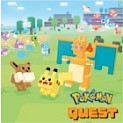Review: Pokémon Quest

Posted 06 Jun 2018 at 13:53 by Adam Hirst
Last week was a big week for Pokémon fans. There was the announcement of the next big games in the Pokémon franchise in Pokémon Let's Go Pikachu/Eevee, both of which will release this November. But what about Pokémon fans who are wanting something to play on their Switch right now? Sure, Pokken Tournament is out but it's pretty old hat at this point.
Luckily the Pokémon Company showed another game at this press event. Pokémon Quest was announced for the Switch and mobile devices and while mobile users will have to wait until June to play the game, Switch owners were treated to a shadow drop, with the game becoming available immediately on the eShop. So, is this free to start game enough to scratch that Pokémon itch or are people best off playing something else?
NOTE: Full disclosure here. While the game is free to start, I did pay the full amount (around £28) on the game. Like other FTS Nintendo/Pokémon games, this game has a maximum amount that can be spent on the game. After that you are no longer able to spend any more.
The game starts off with you setting sail on a little boat towards a place named Tumblestone Island. It's here where your Pokémon quest will start. Your first order of business is to give your Pokémon trainer a name, followed by picking a starter Pokémon for you to use. Seeing as this game only features the original 151, the starters on offer here include Charmander, Bulbasaur, Squirtle, Eevee and Pikachu. The addition of Eevee and Pikachu is probably in order to help promote the newly announced games. For my play through of the game I chose Pikachu. The little mascot has always been a favourite of mine and I was happy to have him fighting by my side again.
After selecting your Pokémon, the game then throws you straight into action and sets your Pokémon away on its journey. Your Pokémon moves through the map of it's own accord. It will always target the nearest Pokémon and then head towards it. While the player has no control over the movement of their Pokémon, he or she is in charge of what special attacks the Pokémon can do. Your Pokémon will have at least one special move that it can use. You do this by either using the control stick to hover the cursor over it and pressing the A button or you can simply press the touch screen to select it, which is my preferred method of playing.
After using a special move it will take some time to recharge it. While your Pokémon is recharging these moves it will still do normal attacks, which, like its movement, it will do automatically. You can select an auto option which takes care of everything for you but it can be a bit hit or miss at times and I only recommend using it if you are confident your team can take on a stage without your supervision or if you simply want to do some grinding.
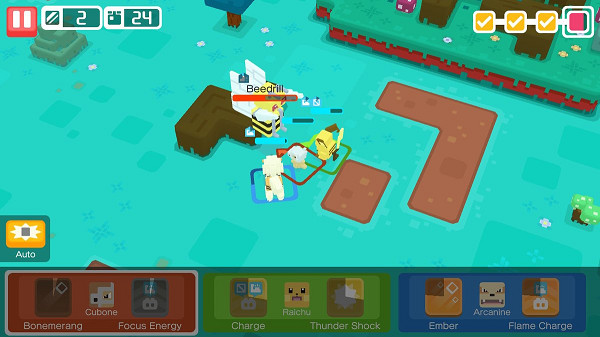 Poor Beedrill didn't have a chance.
Poor Beedrill didn't have a chance.
While fighting your way around the stage you will notice that Pokémon attack you in waves. The amount of waves on each stage is represented by boxes and these can been seen in the top right of the screen. Defeating Pokémon will fill up each of these boxes and once all of the smaller ones have been filled, a large Pokémon will appear. This is the boss of the stage you are exploring and it hits a lot harder than standard Pokémon. If you defeat the boss you will clear the map and be able to move on to the next one.
Once a boss is defeated you will be rewarded with a bunch of items that will help you out on your adventure. These come in the form of various ingredients and power stones. The ingredients can be used to lure Pokémon to your camp (more on that later) and the power stones are used to power up your Pokémon. The stones themselves offer various abilities, such as increasing your health and attack power or powering up the special moves you can do. Each of the Pokémon have a number of slots that these stones can be attached to. The ones that increase your health and attack power are tied to the level of your Pokémon. The higher the level of your Pokémon the more stones can be attached to it. Once one reaches level 100 you will be able to attach the full amount.
The other stones can be attached to your Pokémon's special moves but this depends on the move itself. For example, a move that can increase the stats of your Pokémon can be attached with a stone that will enable this move to affect all Pokémon in your party. Another stone can be used to let you do a double attack but with the caveat that your move will take longer to recharge. These stones can be stacked on your Pokémon and can offer a great advantage in battle. One of my go to strategies was to use a move like Harden but by having a stone that lets it affect my whole team, as well as another that increases the amount of time the effect of Harden stays on my Pokémon, this meant I got the very best out of a single turn. The strategy on offer here gets incredibly complex as the game goes on but by looking out for these things early on can really give your team the edge.
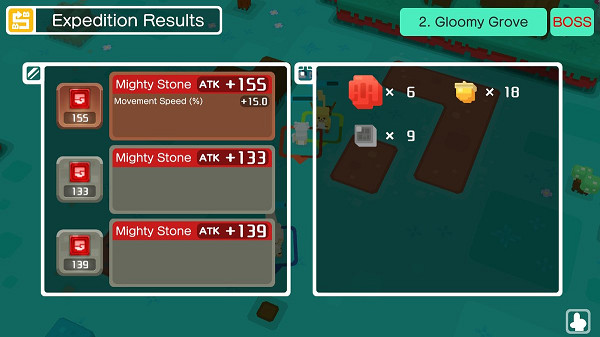 These stones are vital in giving your team the edge.
These stones are vital in giving your team the edge.
After tackling your first map you will be sent back to camp. As I mentioned earlier, you will get ingredients from the battles that you win. These ingredients can be used to expand your team. This is done by throwing them all in the mixing pot and then completing a number of quests. You see, to catch Pokémon in this game you need to lure them into your camp. Pokémon will smell the goodies you are cooking in your pot and after a number of quests have been completed they will pop in and join your team. What Pokémon and the level they are will depend on what pot and recipes you use.
You start off with a normal cooking pot that will only attract low level Pokémon. Later in the game you will unlock new pots which will eventually attract Pokémon as high as level 100. The ingredients you use will dictate which Pokémon will visit your camp. There are a bunch of recipes to learn (or you could look them up online) and each of them will help you bolster your ranks. This really comes in handy if you are in need of a certain type of Pokémon for the up and coming stages. Need a fire type? Then use the recipe that attracts red Pokémon or fire types. Once the ingredients are in the pot then a number will appear above it. This is how many expeditions needing to be completed before the pot will finish cooking. You can actually fail the expedition and this will still count towards the counter.
Also available at the camp is the ability to set decorations around the area. These decorations offer a variety of bonuses for the player. Things like increasing the drop rates of ingredients, increasing your experience points from battles or attracting more Pokémon from a single session of your cooking pot. Some of these are earned by finishing the final stage in an area. These usually offer exp bonuses for Pokémon up to a certain level. Once obtained you can then place these decorations in your camp area. You don't actually have to place them (once you have them in your inventory the effects will kick in) but it's nice to see them placed around the area. You can also buy decorations but this requires the use of Pokémon Tickets. So, how do you earn these?
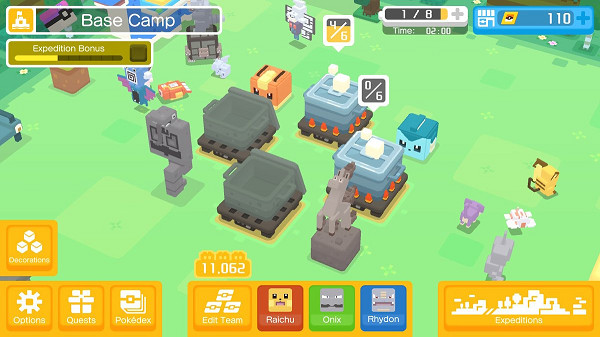 Hopefully your camp will look much more ordered than mine.
Hopefully your camp will look much more ordered than mine.
Pokémon Tickets are the currency of the game. These can be earned by signing in on a daily basis. Every 22 hours the game will dish out a handful of new tickets and a new Pokémon will come visit your camp. There are also a bunch of quests that the game offers which also dish out the tickets. These quests come in two different styles. The first is Main quests. These are one time only challenges which usually comprise of beating a stage or cooking a certain amount of times. The other quests are Challenges. These are repeating quests that require players to defeat a certain type of Pokémon or getting a certain Pokémon type on your team. Completing these quests will add to your ticket tally, as well as give you more ingredients.
Sticking with the camp area, there is another thing to play around with outside of the battling and this is the Edit Team option. The obvious thing to this is the ability to switch your Pokémon team about but there is something else on offer here. You can train your Pokémon to either learn a different move or level it up some more. Both of these are done by sacrificing a Pokémon for the greater good.
First up is the Move Learning section. Lets say that I have a Pikachu that I would like to learn a different move. I could select a Pokémon to teach Pikachu a move but in doing so it would leave my team. If it's the same type as the Pokémon you are using then the move will be learned 100% of the time with a single Pokémon. However, if you use a different type then you may have to use several Pokémon to get the percentage up to an acceptable level. The downside to learning a move is that it is random which one is given to your Pokémon. I found it best to use low level Pokémon in this process, so nothing of real value is lost.
The Level Up section works in a similar fashion. If you use a Pokémon of the same type then it will gain a substantial boost in experience. Use a different type and the amount you get is pretty rough and usually not worth the effort. The good thing about levelling up this way is that it is a lot faster than what it takes to level up by doing expeditions, especially if you use a Pokémon that is a higher level than the one you are wanting to level up.
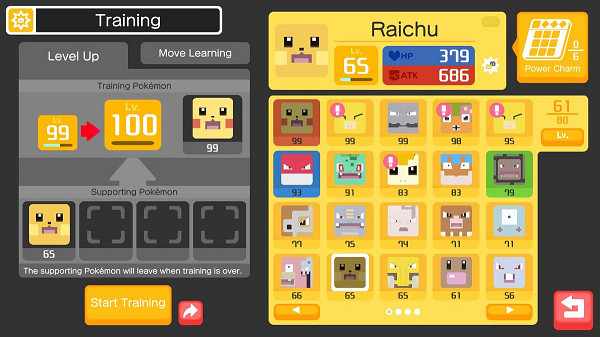 Neither Pokémon look thrilled to be part of the levelling up process.
Neither Pokémon look thrilled to be part of the levelling up process.
Phew! I imagine that was a lot to take in but things certainly become very clear once you starting using these systems. With those out of the way, lets take a look at how the game progresses, shall we?
The game has 11 areas to conquer, with another few more sets opening up in the post game. The areas start off by having only 3 or 4 stages but eventually these go up to 5 or 6. Each of the final stages has a battle with a harder boss fight than what you've previously fought in a stage. Defeat the boss and more areas will open up. Sometimes there are multiple areas that will open up at once. This helps players out because if you happen to get stuck on a certain stage then you can hop to another area and try one of those stages out. I had to do this a few times during my time with the game and it certainly helped me to move on instead of simply being stuck in a single area for a long period of time.
Each of the stages will show the player a recommended power level. This number is what your teams full power should at least be at. This number is calculated by how many of the power stones they are holding. So, the higher the level of the Pokémon, the more stones the Pokémon can hold, which the means the higher their power level will be, which in turn means that the harder stages will be able to be tackled. The harder the stage then the better the rewards. This is the gameplay loop that the game offers and I found it to be quite a fun one. But it doesn't end there. At the area select screen the game will let you know that there is a Type Bonus. This tells you that if you use a certain element type then you will gain a significant power boost for your team. This comes in super handy because you can compensate a lower power level by adding in a type advantage to your team. Have a team that is full of Pokémon with a type advantage and you should be able to tackle it at a level that is a lot lower than is recommended.
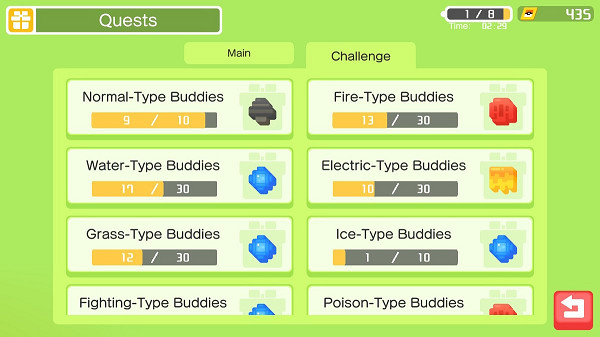 Here's a small selection of the quests that the game offers.
Here's a small selection of the quests that the game offers.
Like most types of mobile games, Pokémon Quest hinders the way players can make progress in the game. At the top right of the screen you can see an energy/battery bar. This shows how many times you can play before needing to wait around half an hour for a single bar to fill back up. You can increase the bar with decorations so that you can get more turns before the gauge runs dry. If you don't want to wait that long then you can use 25 of your Pokémon Tickets to fill the meter back up, of course this means you will be using tickets that could be better saved for something else. If you buy the full package then you will gain a bunch of decorations from the start which upgrades the gauge and gives you around 190 tickets a day. This doesn't get rid of the limit altogether but it certainly does increase your play time substantially.
Even if you have a bunch of tickets at your disposal it will still take a fair bit of time to get through the game. You will have to take advantage of the type advantages, switch your team up in order to use certain moves, grind for ingredients to lure in more Pokémon and all of that is before you even start looking at filling in the Pokédex. There is a great amount of content on offer here and I imagine it's going to take a while to see all of what's on offer in the post game area.
N-Europe Final Verdict
Pokémon is an IP that is very diverse and once again this is shown with this title. If you choose to pay for the game then your experience will be a faster one than those who opt to show more patience. Whether you choose to take the faster route or not, what you will get here is a surprisingly deep game which requires players to think about team composition, base building and time management. I often have more fun with Pokémon spin-offs than I do with the main games and Pokémon Quest is no exception. This is one of the best Pokémon themed games I have played for a while and while I have completed the story mode, i'm still dipping in and out of the game in order to tackle the post game island. The game is free and I encourage everyone to at least give it a try. What have you got to lose?
- Gameplay4
- Playability4
- Visuals4
- Audio4
- Lifespan3
Final Score
8
Pros
Addictive gameplay loop
Lots of depth to the game
There's a limit to how much you can spend on the game
The core collecting aspect of the Pokémon games remain intact
Cons
Lots of grinding is involved
Visuals may put a lot of people off
Progress is slow if you stick to the free to start model


